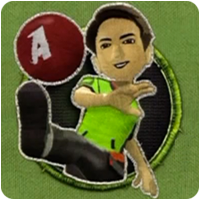Ghostwire Tokyo
LQ: 9.7
Recommended Age: 12+
Skills Used: Flexibility, Working Memory, Reading

In this game, players have to use their entire bodies to deflect balls and hit them down the court. Balls will shoot down a lane towards the player, and the player must hit the balls back and destroy targets at the end of the lane. When the player stands in front of the Kinect sensor, her likeness is represented on the screen, and she must use her whole body to move about the screen and block the balls. In order to send the balls back quickly, players can kick or slap them down for more speed. Because the game features no violence or inappropriate content, no academic skills are needed to play, and the controls are easy to learn, it is recommended for children ages 5 and up.
Adapting and adjusting to changing conditions and expectations.

In this game, players need to stay on their toes—literally—in order to react quickly to the flurries of balls bouncing towards them. Players must block the balls and hit them back down lanes in an effort to destroy the targets located at the end of the lane. As they do this, more balls continually come into play, so eventually players will need to extend their legs and arms, twist their hips, and even head-butt balls in order to keep as many balls in play as possible -- all while trying to aim their shots at the targets. Players who have trouble staying loose and flexible will find it difficult to keep all of the balls in play.
Use this PlayTogether guide to learn how you can help your child turn Kinect Adventures: Rally Ball play time into a positive learning and relationship-building experience. To learn more about why playing games with your children is so important, check out our Science of Play page!
Take a minute to talk with your child about how the Flexibility thinking skill works, and why it's important for success in school and at home.
 Kinect Adventures: Rally Ball offers both single-player, and multiplayer game modes, so the best way to play with your child is to play cooperatively. Take a moment to examine the gameplay goals below and then jump into the game and try to complete them with your child.
Kinect Adventures: Rally Ball offers both single-player, and multiplayer game modes, so the best way to play with your child is to play cooperatively. Take a moment to examine the gameplay goals below and then jump into the game and try to complete them with your child.
Gameplay Goals:
 After you have played through ten rounds of of Kinect Adventures: Rally Ball, take a minute to pause the game and talk with your child about how the game is exercising your Flexibility skills.
After you have played through ten rounds of of Kinect Adventures: Rally Ball, take a minute to pause the game and talk with your child about how the game is exercising your Flexibility skills.
Our Make it Real activites are designed to transform your child’s gameplay into real-world improvements in thinking and academic skills. If you’re just getting started with LearningWorks for Kids, we suggest you try them all to find which are the best for you and your child.
Read over the page for Flexibility. Then take some time to introduce this thinking skill to your child.
Explain That:

Get unstuck. Inflexibility can prevent you from finding a range of correct solutions to a particular problem. One way to help your child see how this behavior results in avoidable frustration is to have her help you out of a situation where you feel stuck. Using the computer is an ideal opportunity for this type of hands-on illustration. Next time you have a problem, keep repeating the incorrect activity or an ineffective remedy, then blame the machine. Tell your child it is the computer that is stuck. Most children are more knowledgeable about computers than their parents and will be able to demonstrate several ways to fix the problem. This, and similar opportunities, will give you a chance to talk about the need for new approaches and solutions at times when stubborn determination to stick to the old way of doing things just isn't working.
Children with ADHD can benefit greatly from vigorous physical activities. Studies show that extended physical exertion can positively effect brain chemistry in a way the boosts attention and memory. Exercising can create a post-workout boost of brain fuel in the areas of the brain for memory and focus. You this temporary boost of attention to good effect by following the strategies below:
All membership plans come with full access to our entire suite of tools learning guides, and resources. Here are a few of the ones we think you’ll like the most: